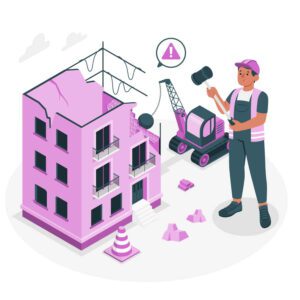Urban spaces are constantly evolving, and as cities grow and change, the need to revitalize and redevelop underutilized areas becomes increasingly important.
While urban redevelopment projects often focus on construction and design, the initial step of demolition plays a crucial role in clearing the way for new development.
In this article, we will explore innovative demolition techniques that are not only efficient and cost-effective but also environmentally friendly.
These techniques are reshaping the landscape of urban renewal and paving the way for sustainable and vibrant cityscapes.
Selective Demolition
Selective demolition is a technique that involves the careful dismantling of specific structures while preserving elements that can be reused or repurposed. This method not only reduces waste but also helps to maintain the historical and architectural character of a neighborhood.

Skilled workers meticulously deconstruct buildings, salvaging materials like bricks, beams, and fixtures for future use. By incorporating elements of the old into the new development, selective demolition fosters a sense of continuity and connection with the past.
Deconstruction
Deconstruction takes selective demolition a step further by disassembling a building with the intention of reusing or recycling its components. It involves the systematic removal of materials such as doors, windows, flooring, and fixtures, which can be repurposed in other construction projects.

Deconstruction reduces waste sent to landfills, conserves resources, and promotes the use of sustainable materials. Additionally, it offers economic opportunities by creating jobs in the recycling and salvage industries.
High-Reach Excavators
High-reach excavators are powerful machines specifically designed for tall buildings and structures. These machines utilize long demolition arms and specialized attachments to dismantle structures from the top down.

By starting at the highest point of a building and working downward, high-reach excavators minimize the risk of structural collapse and reduce the impact on surrounding areas. This technique is particularly useful in densely populated urban environments where traditional demolition methods may pose safety concerns.
Implosion
Implosion is a controlled demolition technique that involves strategically placing explosives within a building to bring it down in a controlled manner. While implosion may seem counterintuitive to sustainability, modern implosion techniques are designed to minimize environmental impact.

Through careful planning and precise execution, implosion can result in more efficient use of resources, reduced noise pollution, and minimized dust and debris. It is often employed in situations where space constraints or safety considerations prohibit traditional demolition methods.
Guidelines for Home & Building Demolition by United States Environmental Protection Agency
Robotic Demolition
Robotic demolition utilizes remotely operated machines equipped with hydraulic hammers, shears, and crushers to dismantle structures. These robotic machines can access tight spaces and perform precise, controlled demolitions, minimizing the risk of damage to neighboring structures.

Robotic demolition also reduces the exposure of workers to hazardous environments, making it a safer alternative. Furthermore, the ability to program and adjust the machines’ parameters allows for greater efficiency and accuracy in the demolition process.
Here are a few examples of cities that have successfully implemented innovative demolition techniques in their urban redevelopment projects:
Detroit, Michigan, USA: Detroit, once known as the Motor City, has faced significant challenges due to population decline and abandoned buildings. The city has embraced selective demolition and deconstruction techniques to revitalize its neighborhoods.
By salvaging materials from vacant structures, Detroit has not only reduced waste but also created opportunities for local businesses specializing in architectural salvage. This approach has been instrumental in preserving the city’s architectural heritage while making space for new development.
Las Vegas, Nevada, USA: Las Vegas is known for its ever-evolving skyline and the constant need to reinvent itself. The city has utilized implosion techniques for demolishing older hotels and casinos to make way for new developments.
Notable examples include the controlled implosion of iconic establishments like the Dunes Hotel and Casino and the Stardust Resort and Casino. These implosions were carefully planned to minimize environmental impact and ensure public safety while allowing for rapid redevelopment.
Tokyo, Japan: Tokyo has faced the challenge of limited space for new construction due to its dense urban environment. The city has turned to robotic demolition techniques to efficiently dismantle structures in tight spaces.
Robotic machines equipped with hydraulic hammers and shears have been deployed to deconstruct buildings, particularly in densely populated areas. This method has proven effective in clearing space for new developments while minimizing disruption to neighboring structures and ensuring worker safety.
These cities serve as examples of successful implementation of innovative demolition techniques in urban redevelopment projects. By embracing such techniques, they have not only transformed underutilized spaces but also demonstrated a commitment to sustainability, preservation, and community well-being.
Demolition Project Management: Planning, Execution, and Challenges.
Conclusion
Reviving urban spaces requires innovative approaches to demolishing existing structures. Through selective demolition, deconstruction, high-reach excavators, implosion, and robotic demolition, cities can efficiently clear the way for redevelopment while minimizing waste, preserving historical elements, and ensuring the safety of both workers and the surrounding community.
These techniques not only contribute to sustainable urban renewal but also create opportunities for economic growth and the revitalization of neighborhoods. By embracing these innovative demolition methods, we can breathe new life into urban spaces and shape cities that are vibrant, eco-friendly, and in harmony with their past.
